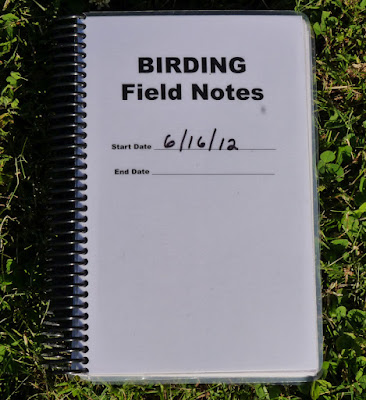I like to keep a record of what I see while I'm out birdwatching but I've never been satisfied with the notebooks or checklists I've used. I finally decided that my best option would be to design my own field notebook instead of buying one online or at a store.
I started out using simple checklists like this one, that recently I found stuffed under my truck seat. Checklists are convenient because the names of the birds are already printed out. All you have to do is record the species you see in check box. I have a few issues with using these checklists. I have a few issues with using checklists like this one:
- There are hundreds of species printed on this list but I only see an average of about 40 per outing.
- The print is very small and there isn't much room to make extra notes or sketches.
- They end up under my truck seat with coffee stains on them instead of being neatly filed away.
I've used notebooks like these to take notes as well. They allow me the freedom to take notes or make sketches but I also have to write in every species I see by hand. That is a tedious chore and my penmanship is not exactly stellar. I was born left handed but for some mysterious reason an elementary school teacher decided I should write with my right hand.
It finally occurred to me that I might be able to design my own customized field notebook. The first step was to put together a checklist of birds that I see most often and then put them on to an excel spreadsheet (with some help from my cousin-thanks Bob). It was difficult for me to decide which species to leave off the list and how to organize them. The order I used was a mix of alphabetical, taxonomic, and whatever I felt would work for me. The final step was went to have the notebooks printed up at a print shop. I opted for using spiral binding and a heavier grade of paper. There are cheaper ways of going about this project, like using a 3 ring binder, but cutting costs was not my primary objective.
Each checklist takes up the front and back of a single page. The back of each page also has room for additional species that weren't included on my checklist. On my first outing with this new notebook I had to write in Orchard Oriole. I don't mind writing a few species in by hand, especially birds that I don't see often.
I decided not to alternate blank pages between the checklists. Instead, I included a separate section in the back in case I decide to make additional notes or drawings which can be referenced back to a particular checklist. The notebook is not perfect but it's better than anything I've used before. The nice part about it is that further adjustments can be made in the future if needed.













